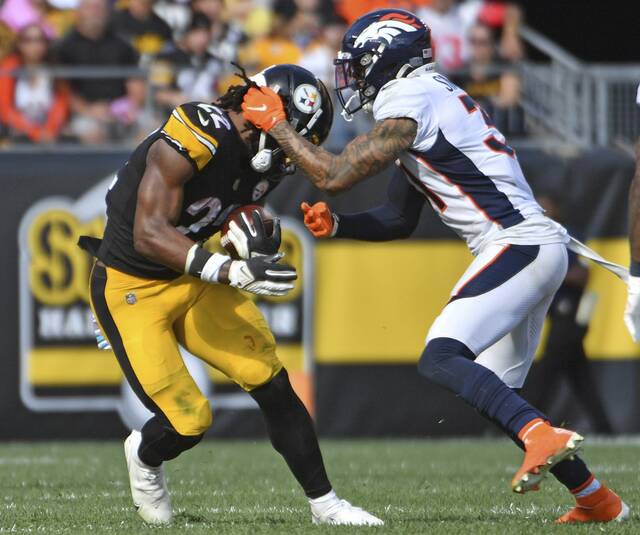https://naviga.triblive.com/sports/5-things-commitment-to-running-game-pays-off-for-steelers/
5 things we learned: Commitment to running game pays off for Steelers

Five things we learned from Steelers 27, Broncos 19:
1. First things first
When team president Art Rooney II said in the offseason that he wanted to see a more effective and efficient running game, what was on display Sunday at Heinz Field likely was what he had in mind.
Last in rushing entering the game, the Steelers made a commitment to improve that ranking and finished with a season-high 147 yards, including 122 from first-round pick Najee Harris.
The commitment was particularly noticed on first down when offensive coordinator Matt Canada called run plays on 13 of 16 opportunities in the first half as the Steelers built a 17-6 lead and controlled the ball for nearly 20 minutes. Harris had a pair of 6-yard runs on first down and a 5-yard run that enabled the Steelers to control the offensive tempo and keep quarterback Ben Roethlisberger out of third-and-long situations.
Harris totaled 89 yards in the first half because of this dedication to running the ball against the Broncos. In the second half, while the Steelers were adding to their lead in the third quarter and then trying to run out the clock in the fourth, Canada called runs on seven of nine first-down plays.
2. Clean pocket
A strip sack in the first quarter produced a fumble recovery that the Broncos turned into a field goal that cut the Steelers’ early lead to 7-3.
It came on a rare time that Roethlisberger held onto the ball for an extended period of time in an attempt to find an open receiver. It also was one of only two times in the game that the Broncos got a hand on the 18-year quarterback.
The sack was the 11th of the season against Roethlisberger, who was brought down 13 times in 15 starts last season. But the play of the offensive line, plus the improved running game, allowed Roethlisberger to play his cleanest game of the season.
After being hit 10 times by Las Vegas, Roethlisberger’s contact rate has gone down each game — seven hits by Cincinnati, five by Green Bay and two by Denver.
It helped Roethlisberger play to his strengths as evidenced by his season-best 120.9 passer rating, the first time this season he finished with a number higher than 87.
3. Going batty
Cameron Heyward’s ability to bat down passes at the line of scrimmage has been a big component of his play this season. Heyward leads all Steelers defenders with five passes defensed. The latest came at an opportune time, as it turned out.
The Broncos had four possessions in the second half. The final three resulted in two touchdowns and a drive to the Steelers 3 that ended with James Pierre’s interception in the end zone.
Lost in the aftermath was Heyward’s pass breakup that forced a punt on the Broncos’ initial drive of the half. After getting three first downs in the entire first half, the Broncos got three to open the third quarter. They had the ball at the Steelers 47 and faced a third-and-7 when Teddy Bridgewater looked to keep the drive going with a pass to Kendall Hinton.
Heyward got his hand on the ball, the Broncos punted and the Steelers embarked on a 14-play, 86-yard drive that increased their advantage to 24-6.
4. Leverage buyout
The Steelers thought they had built on their 17-6 halftime lead with Chris Boswell’s 51-yard field goal on their opening possession of the third quarter. But Denver’s Dre’Mont Jones was flagged for violating a rule the NFL adopted just a few years ago.
In an effort to protect long snappers on field goals and extra points, the NFL ruled that defensive players could no longer use them as “leverage” to try to initiate a blocked kick or punt. The Steelers benefited from this when Jones was called for making contact with Christian Kuntz.
The Steelers accepted the penalty and scored a touchdown three plays later on Roethlisberger’s 18-yard pass to Chase Claypool. Those four extra points came in handy when the Broncos were driving down the field in the waning moments. Instead of trailing by eight points, the Broncos likely would have been down 23-20 had Jones not been called for leverage. And they would have needed just a field goal — instead of a touchdown and 2-point conversion — to force overtime.
5. Mix and match
The absence of cornerback Cam Sutton required some creativity on defense, and the Steelers brought out some unseen packages against the Broncos.
Without Sutton to move inside in the nickel and dime formations, the Steelers used Arthur Maulet primarily as the slot cornerback. He played 45 of the 60 defensive snaps. The Steelers also worked in rookie Tre Norwood as an extra safety, and Karl Joseph played two defensive snaps in his Steelers debut. Even core special-teamer Miles Killebrew played a snap.
The Steelers also kept three outside linebackers on the field for eight snaps. Melvin Ingram typically lined up inside while T.J. Watt and Alex Highsmith played their normal roles outside. The changes were effective — for three quarters, at least, when the Broncos had just 135 yards on their first six possessions.
Inside linebacker Robert Spillane also got some playing time in the dime defense.
Copyright ©2025— Trib Total Media, LLC (TribLIVE.com)
